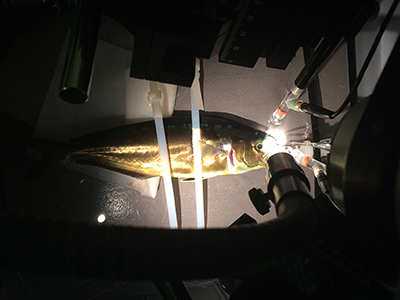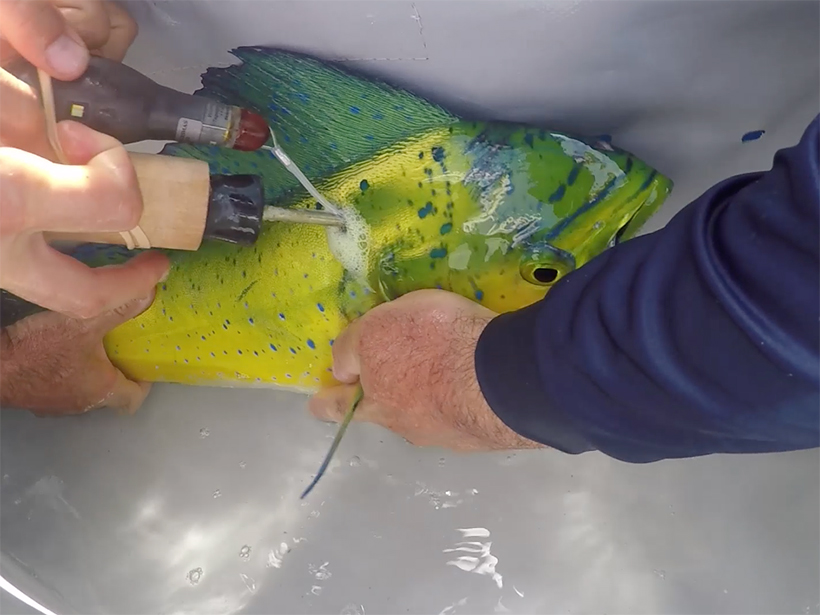In the aftermath of oil spills, photographs often depict oil-drenched pelicans and sea otters, but under the water and away from the public eye, fish species are also affected.
Following the 2010 Deepwater Horizon oil spill, which spewed nearly 5 million barrels of crude oil into the northern Gulf of Mexico, the Programmatic Damage Assessment and Restoration Plan estimated that between 2 trillion and 5 trillion fish were killed.
Lela Schlenker, a fish physiological ecologist at the University of Miami, added that this estimate “didn’t account for the sublethal effects of exposures” on fish such as red snapper and mahi-mahi. These effects, which can include reduced cardiac output, visual acuity, and swimming speed, don’t immediately kill fish but can cause harm or eventually lead to their deaths.
The Deepwater Horizon spill overlapped with the prime location and timing of mahi-mahi spawning, said Schlenker. To investigate whether affected mahi-mahi can still detect and avoid oil exposure (and its unhealthy effects), she and her colleagues conducted behavioral and electrophysiological tests on juvenile fish in captivity. Each fish was either exposed to an oil mixture (within the concentration range measured after the Deepwater Horizon disaster and prepared by diluting oil collected from the spill) or held in control conditions.

Remarkably, oil exposure didn’t damage the sense of smell in mahi-mahi, according to the results of electro-olfactogram (EOG) experiments, which measured and recorded changes in electrical potentials in tissues of the fish’s nasal cavities.
“It was surprising to me that 24 hours of oil exposure did not seem to impact EOG responses to oil or other odorants,” Tricia Meredith, an assistant research professor studying olfaction in elasmobranchs at Florida Atlantic University, wrote in an email to Eos.
“This may be due to a lack of peripheral impacts or it may be due to some other factor, like the duration or concentration of the oil exposure, the particular odorants chosen for the experiment, the EOG protocol used, or the type of oil used,” added Meredith, who wasn’t involved with the study.
Lack of Avoidance
Behavioral testing, however, showed that mahi-mahi in the exposed group were less likely than those in the control group to avoid additional exposure to oil.
During the behavioral experiments, the fish were tested with seawater containing polycyclic aromatic hydrocarbons (PAHs). PAHs are toxic components of oil that have previously been shown to affect behavior patterns in different fish species.
It’s “alarming that even though the fish can apparently detect oil in the water, they don’t seem to avoid it after just a day of exposure.”
The oil-exposed fish were neither attracted to nor avoidant of the oil. Schlenker thinks this change could be due to central nervous system damage in exposed fish and also noted that more work is needed to understand how oil exposure in one generation of fish affects future generations—research that scientists at the University of Miami are currently conducting.
Meredith expressed some surprise at the study’s dual results. It’s “alarming that even though the fish can apparently detect oil in the water, they don’t seem to avoid it after just a day of exposure,” she wrote.
The new research was published in Environmental Science and Technology.
—Rachel Crowell ([email protected]; @writesRCrowell), Science Writer
Citation:
Crowell, R. (2020), Oil-exposed mahi-mahi more likely to lose oil-avoidance behavior, Eos, 101, https://doi.org/10.1029/2020EO139316. Published on 30 January 2020.
Text © 2020. The authors. CC BY-NC-ND 3.0
Except where otherwise noted, images are subject to copyright. Any reuse without express permission from the copyright owner is prohibited.

